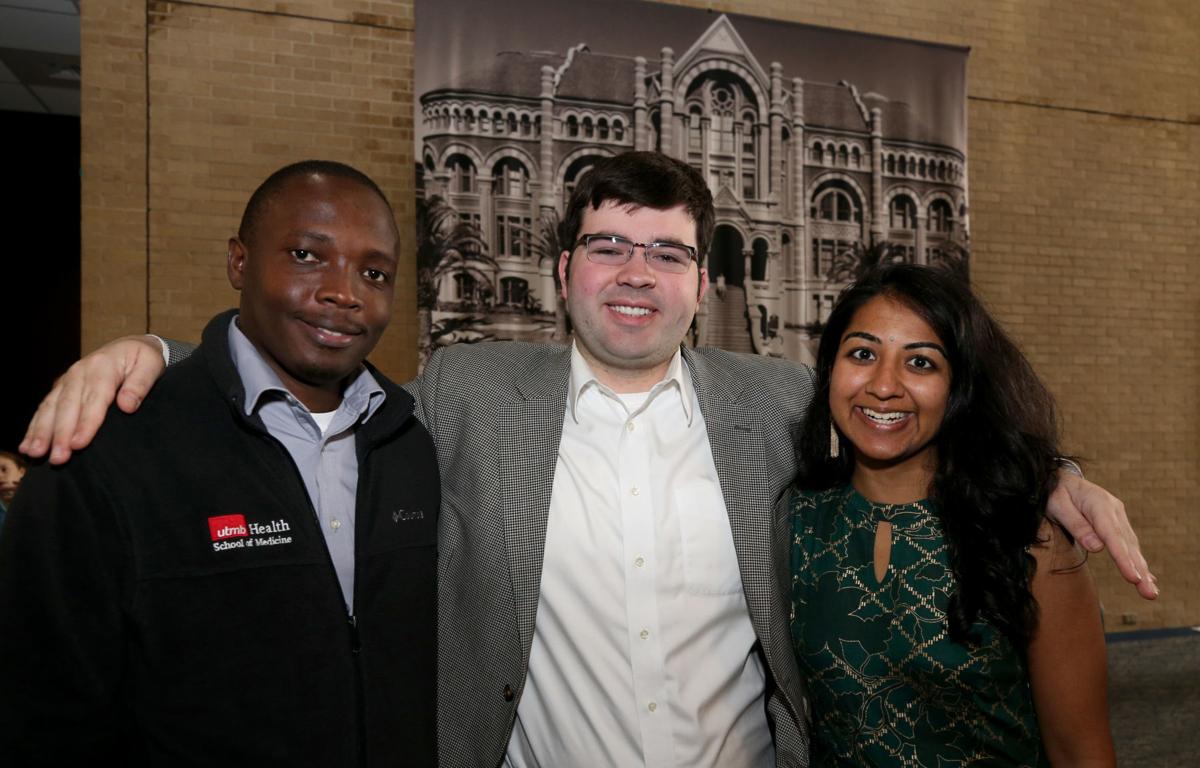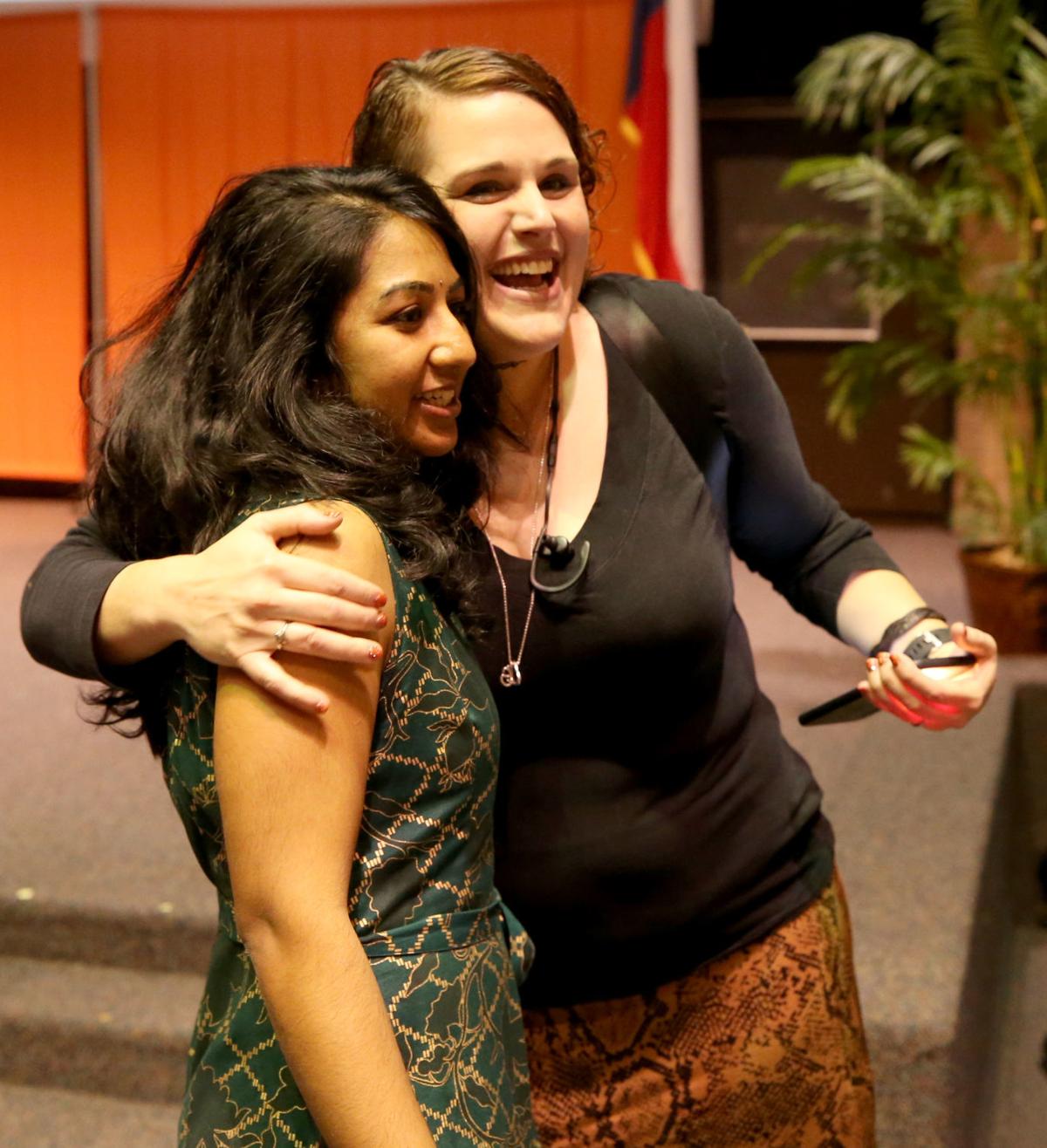Published with permission from The Daily News.
By KATHRYN EASTBURN The Daily News
Posted: Mar 16, 2019

Medical students Eric Nezerwa, left, Edward Strecker and Mauli Dalal are headed to Family Medicine residency programs when they graduate from the University of Texas Medical Branch.
JENNIFER REYNOLDS/The Daily News

Mauli Dalal, left, gets a hug from Shannon Samuelson, a Family Medicine Interest Group coordinator, after matching to the Family Medicine residency program at the University of Utah Affiliated Hospitals in Salt Lake City during the annual Match Day celebration at University of Texas Medical Branch in Galveston on Friday, March 15, 2019.
JENNIFER REYNOLDS/The Daily News
Eric Nezerwa gets his Match Day letter during the annual celebration at University of Texas Medical Branch in Galveston on Friday, March 15, 2019. Nezerwa matched to the the Family Medicine program at the medical branch.
While the national trend among medical school graduates is toward specialty practices and away from primary care, especially family medicine, three soon-to-be University of Texas Medical Branch graduates chose the family medicine track based on their unique life experiences.
At match day on Friday at the medical branch, Mauli Dalal, Edward Strecker and Eric Nezerwa all found residencies at family medicine training programs.
Dalal, who grew up in Lake Jackson, entered medical school at 19 following a rigorous high school course at the Texas Academy of Math and Science and college admission after 10th grade to the University of North Texas where she graduated in three years.
“I was very interested in emergency medicine back then,” Dalal said. “I was an over-achiever going into med school.”
She found herself questioning the narrow path she’d carved for herself and, encouraged by faculty, took a year off to do a work-study program under the medical branch’s physician healer track. During that year, she spent three months studying under a Zen master at a monastery in the foothills of the Appalachian mountains.
“I didn’t have much time to grow,” Dalal said. “I’m really grateful that the school is very supportive of student health.”
Through the physician healer track, Dalal said she learned to connect with other people better and was introduced to alternative healing modalities that can be integrated into a traditional medical practice.
“That led me in the direction of primary care,” she said. “I want to help others with their whole lives.”
Dalal applied to residency programs around the country in family medicine, looking for programs that incorporate lifestyle modalities like nutrition and counseling. She will start her residency at University of Utah Affiliated Hospitals in Salt Lake City in July.
A ONE-STOP SHOP
“To my knowledge, UTMB is the only medical school in Texas with a rural track,” said Edward Strecker, a graduating medical student who matched for a family medicine residency at Conroe Regional Medical Center in Montgomery County.
Strecker, who grew up in Plano, knew from an early age he wanted to be a rural family doctor, a one-stop shop in a small community where the nearest medical center might be two hours away.
“My high school had a work-study program where you could work at a hospital half the day,” Strecker said. “That turned me on to primary care. I saw how building up a relationship with a doctor could really have an impact.”
Strecker graduated from Georgia Tech with a degree in bio-engineering before starting medical school and gravitating immediately toward the rural family medicine track.
“It has allowed me to serve in an underserved community, a rural county, where I connected with my mentor, Dr. Adrian Billings, out in West Texas,” Strecker said.
Strecker became involved in Frontera de Salud, a student-run service and education project, and was part of a mission trip to Presidio, Texas, a small border town, where he met Billings. From there, on the last day of the trip, he and others staged a clinic in Candelaria, an even smaller border town, where the church was outfitted for a day to assess patients and get them needed medications and whatever treatment could be provided.
The next year, Strecker became president of the Frontera de Salud group at the medical branch, in part to provide medical resources to rural communities, but also to raise student awareness of the needs of underserved communities.
Strecker hopes to practice family medicine somewhere in Texas, he said.
A GREAT LEARNING EXPERIENCE
Eric Nezerwa was inspired to enter the field of family medicine by his father, a physician in Rwanda, where Eric was born, who had to flee the country during the 1994 Rwandan genocide.
“We went to Congo and lived in a small town where my dad worked as the only physician for a year or two,” Nezerwa said. The family left the Congo when war was breaking out there and fled to Tanzania, then to Malawi where they lived in refugee camps, and eventually to Zambia. The family applied for resettlement as refugees to the United States and ended up in Dallas.
Nezerwa’s father was unable to be reinstated as a physician in the United States, but passed on his passion for healing to his son.
“I saw my dad treating people when we were refugees,” Nezerwa said. “I became really interested in primary care. I wanted to do exactly what my dad did, so I took the family medicine track. He was trained in internal medicine, but in the places where we lived, he was treating everybody — pregnant women, children, everyone.”
Nezerwa moved to Galveston for medical school in 2015 and will begin his family medicine residency at the University of Texas Medical Branch this summer.
“It’s been a great learning experience for me here,” he said. “Medicine is different here. Patients have more rights. They have more say about their treatment and what they want their care to be from their doctor.”
The American Academy of Family Physicians estimates that by 2020 the United States will need nearly 140,000 family physicians to meet the nation’s need for primary care, but currently attracts and trains only half the number of future family physicians required to meet that need.